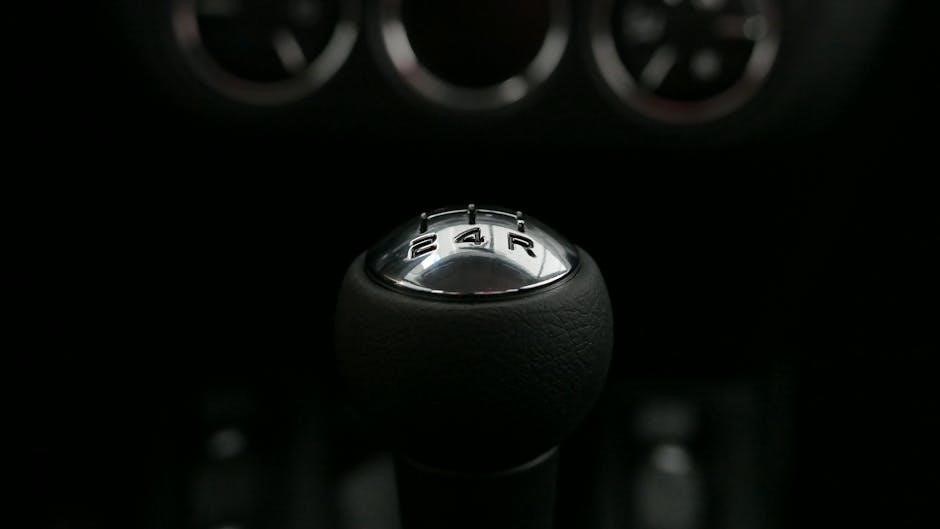
Manual transmissions have evolved with 5 and 6 speed options‚ offering drivers a choice between these two configurations‚ each with unique characteristics and benefits‚ including fuel efficiency and performance capabilities‚ using various gear ratios.
Overview of Manual Transmissions
Manual transmissions are a type of transmission that requires the driver to manually change gears using the clutch pedal and gearshift. They have been used in vehicles for many years and are still popular today‚ with many drivers preferring the control and connection to the vehicle that they provide. The basic components of a manual transmission include the gearbox‚ clutch‚ and gearshift‚ which work together to transmit power from the engine to the wheels. Manual transmissions are typically less complex and less expensive to maintain than automatic transmissions‚ which makes them a popular choice for many drivers. They are also often preferred by drivers who enjoy the driving experience and want to be more involved in the process of shifting gears. Overall‚ manual transmissions offer a unique driving experience and are a popular choice for many vehicle owners‚ with various applications and configurations available‚ including 5 and 6 speed options.

Performance Comparison of 5 Speed and 6 Speed Transmissions
Comparing 5 and 6 speed transmissions reveals differences in acceleration and top speed capabilities‚ with 6 speed transmissions offering improved performance and smoother shifting‚ using various gear ratios and configurations.
Differences in Gear Ratios and Overdrive
The main difference between 5 speed and 6 speed transmissions lies in their gear ratios and overdrive capabilities. A 6 speed transmission typically has a more extensive range of gear ratios‚ allowing for better acceleration and fuel efficiency. The additional gear in a 6 speed transmission often serves as an overdrive gear‚ which helps to reduce engine RPM at high speeds‚ resulting in improved fuel economy and decreased engine wear. In contrast‚ 5 speed transmissions usually have a more limited range of gear ratios‚ which can lead to decreased fuel efficiency and increased engine wear at high speeds. The differences in gear ratios and overdrive capabilities between 5 speed and 6 speed transmissions can have a significant impact on a vehicle’s overall performance and efficiency. Additionally‚ the gear ratios and overdrive capabilities of a transmission can be tailored to suit specific driving conditions and vehicle types. This allows manufacturers to optimize their transmissions for various applications‚ from high-performance sports cars to fuel-efficient family sedans‚ using various configurations and technologies to achieve the desired results and meet the needs of different drivers and vehicles.

How 5 Speed and 6 Speed Transmissions Affect Driving Experience
Transmissions impact driving feel‚ with 5 and 6 speeds offering distinct shifting experiences and driver engagement levels‚ influencing overall vehicle handling and control‚ using manual gearboxes and clutch systems effectively always.
Impact of Transmission Type on Fuel Efficiency
Manual transmissions save 5-15% on fuel cost compared to automatic transmissions‚ which are designed to choose the best gear for any situation‚ but may not always optimize fuel efficiency. The difference in fuel efficiency between 5-speed and 6-speed manual transmissions is largely due to the additional gear ratio in the 6-speed‚ allowing for a more optimized engine speed and better fuel economy. According to various studies‚ 6-speed manual transmissions can provide better fuel efficiency‚ especially in city driving or hilly terrain‚ where the additional gear ratio can help to reduce engine load and improve fuel economy. Furthermore‚ the design of the transmission‚ including the gear ratios and final drive ratio‚ can also impact fuel efficiency‚ making it essential to consider these factors when evaluating the impact of transmission type on fuel efficiency. This information is crucial for drivers seeking to optimize their vehicle’s fuel efficiency.

Design and Functionality of 5 Speed and 6 Speed Transmissions
Transmissions feature complex mechanical systems with gears‚ shafts‚ and bearings‚ requiring precise engineering and manufacturing to ensure smooth operation and reliability‚ using various materials and technologies‚ every day.
Key Components of Manual Transmissions
Manual transmissions consist of several key components‚ including the gearbox‚ clutch‚ and gearshift. The gearbox is the main housing for the gears‚ bearings‚ and shafts‚ and is typically made of cast iron or aluminum. The clutch is a friction plate that connects and disconnects the engine from the transmission‚ allowing the driver to shift gears smoothly. The gearshift is the lever that the driver uses to select the desired gear‚ and is connected to the gearbox through a system of linkages and cables. Other important components of manual transmissions include the flywheel‚ pressure plate‚ and throwout bearing‚ which all work together to provide a smooth and reliable shifting experience. Additionally‚ manual transmissions often feature synchronizers‚ which help to match the speed of the gears during shifting‚ and bearings‚ which support the shafts and gears. Overall‚ the key components of manual transmissions work together to provide a precise and controlled driving experience.

Real-World Applications of 5 Speed and 6 Speed Transmissions
Various vehicles utilize 5 and 6 speed transmissions‚ including sports cars and trucks‚ offering unique driving experiences and capabilities‚ with applications in racing and everyday driving situations‚ using different gear ratios.
Examples of Vehicles with 5 Speed and 6 Speed Transmissions
Several vehicles are equipped with 5 and 6 speed manual transmissions‚ including the Porsche 911‚ which features a 6-speed manual transmission‚ and the BMW 540i‚ which also has a 6-speed manual transmission. Other examples include sports cars and trucks‚ such as the Ford Mustang and the Chevrolet Camaro‚ which offer 5 and 6 speed manual transmission options. These vehicles demonstrate the versatility and performance capabilities of 5 and 6 speed transmissions. Additionally‚ some vehicles‚ like the Audi TT‚ come with a 6-speed manual transmission as standard‚ while others‚ like the Volkswagen Golf‚ offer a 5-speed manual transmission. The use of 5 and 6 speed transmissions in various vehicles highlights their reliability and efficiency in different driving conditions. Overall‚ the examples of vehicles with 5 and 6 speed transmissions showcase their widespread application and popularity in the automotive industry‚ with many manufacturers offering these transmission options in their vehicles‚ providing drivers with a range of choices.
